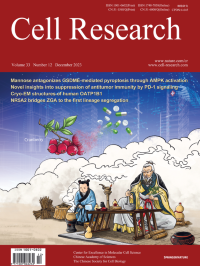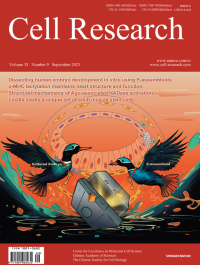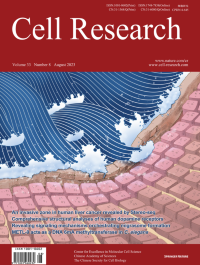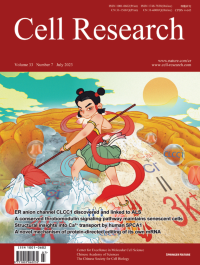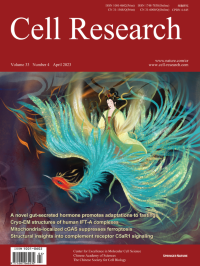Volume 33
-
No. 12 December 2023
Alleviating suffering helps the completion of medical procedures and is the perpetual pursuit of medical professions. As early as in Han dynasty, Hua Tuo made the herbal anesthetic potion “Mafeisan” for surgery. The contemporary mannose extracted from cranberry mitigates the side effects to complement chemotherapeutic procedures. See page 904–922 by Yuan-li Ai et al. for details.
-
No. 11 November 2023
This cover portrays a flowing river, symbolizing the aging of a mother, surrounded by jujube and lotus plants. The seeds of these plants, standing as symbols of having many children, are traditionally given as gifts to newlyweds in Chinese culture to bestow blessings of fertility. Within the river, there are mitochondria undergoing shifts from tubular to donut-shaped structures as the mother ages. These mitochondria, inherited by the offspring, have enduring impacts on their trait formations. See page 821–834 by Runshuai Zhang et al. for details.
-
No. 10 October 2023
Nüwa is a mother godness in Chinese culture who molded humans with yellow clay. The clay models show the 46 chromosomes in each cell of human body. A complete genome of a male Han Chinese with all 46 chromosomes assembled at telomere-to-telomere level is presented. See page 745–761 by Chentao Yang et al. for details. The image is credited to Cheng Guo and Huifang Xiao.
-
No. 9 September 2023
The image shows a Chinese idiom of “flying together”, wherein one bird represents “Cultured Embryo” and the other bird represents “E-assembloid”, and they carry the keys to together open the black box of human peri-implantation development. See page 661–678 by Zongyong Ai et al. for details.
-
No. 8 August 2023
This image depicts a process where a river overflows its banks. Dikes built on the river play a key role in protecting its surrounding farmland from flooding. Likewise, during the development of solid tumors, malignant tumors continue to grow (surging flooding), constantly erode the invasive zone (dikes along the river) and destroy paratumoral tissues (normal farmland). See page 585–603 by Liang Wu et al. for details.
-
No. 7 July 2023
The lotus beneath Nezha, a fairy tale character, represents an ER anion channel CLCC1. Chloride through CLCC1 compensates both potential and osmolality changes during ER Ca2+ release together with K+ (2Ca2++Cl–=3K+). CLCC1 dysfunction leads to imbalance of ER ion homeostasis (2Ca2+=4K+), ER swelling, and neurodegeneration, which is linked with ALS represented by Nezha’s frozen leg and spear. See page 497–515 by Liang Guo et al. for details.
-
No. 6 June 2023
The cover image illustrates the Lugou Bridge, which is one of the most famous scenic spots and the oldest existing stone arch bridge in Beijing. The stone lions carved above the stone guardrail are in different shapes, just like the heterogeneous fate choices of hemogenic endothelial cells on the way to become hematopoietic stem cells. See page 448–463 by Jun Xia et al. for details.
-
No. 5 May 2023
The artwork references history by depicting the concept of the Confucian “Doctrine of the Mean”. Tilting vessel, also known as yòu zuò zhī qì, is an ancient Chinese vessel that needs to be filled with an appropriate amount of water to maintain its upright position. Overfilling or underfilling the vessel can render it unstable. Likewise, CAR tonic signaling must be fine-tuned to ensure that it is neither too weak nor too robust, thereby optimizing CAR-T cell fitness. See page 341–354 by Jian Chen et al. for details.
-
No. 4 April 2023
The image shows a Chinese fairy tale, the “Blue Bird as a messenger”, wherein Blue Bird delivers messages for Xiwangmu (the Immortal Queen Mother). The Blue Bird is reminiscent of famsin, a novel gut-secreted hormone, which mediates communication between the intestine and other organs to promote metabolic adaptations to fasting and enhance animal survival when food is scarce. See page 273–287 by Aijun Long et al. for details.
-
No. 3 March 2023
A study revealed that SARS-CoV-2 generates Z-RNA during virus infection. The left-handed Z-RNA ignites ZBP1-RIPK3-MLKL necroptosis pathway. The RIPK3 scaffolding functionality additionally promotes chemokine production to magnify the inflammatory responses. These synergistically lead to SARS-CoV-2-triggered lung damage and COVID-19. See page 201–214 by Shufen Li et al. for details.
-
No. 2 February 2023
A study identified a novel APOE4-specific receptor LilrB3. A butterfly-like Cryo-EM structure of the complex reveals the details of how the immune “checkpoint” receptor LilrB3 recognizes APOE4. Upon binding, it will induce microglia cell into an Alzheimer Disease-associated status. See page 116–130 by Jiayao Zhou et al. for details.
-
No. 1 January 2023
The image tells a fable story, ‘dirty partner’. A wolf and a jackal often do evil things in collusion with each other. In KRAS-driven cancers, KRAS mutations are like wolves and RASON behaves like a jackal. KRAS mutations initiate tumour formation and promote tumour progression which are enhanced by RASON, a novel protein encoded by long non-coding RNA, LINC00673, and overexpressed in tumour to regulate RAS activity. Cover art is contributed by Chao Yan. See page 30–45 by Rongjie Cheng et al. for details.

